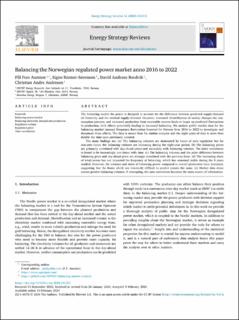| dc.contributor.author | Austnes, Pål Forr | |
| dc.contributor.author | Riemer-Sørensen, Signe | |
| dc.contributor.author | Bordvik, David Andreas | |
| dc.contributor.author | Andresen, Christian Andre | |
| dc.date.accessioned | 2024-03-11T13:15:05Z | |
| dc.date.available | 2024-03-11T13:15:05Z | |
| dc.date.created | 2024-03-04T17:43:16Z | |
| dc.date.issued | 2024 | |
| dc.identifier.citation | Energy Strategy Reviews. 2024, 52 . | en_US |
| dc.identifier.issn | 2211-467X | |
| dc.identifier.uri | https://hdl.handle.net/11250/3121833 | |
| dc.description.abstract | The balancing market for power is designed to account for the difference between predicted supply/demand of electricity and the realised supply/demand. However, increased electrification of society changes the consumption patterns, and increased production from renewable sources leads to larger un-predicted fluctuations in production, both effects potentially leading to increased balancing. We analyse public market data for the balancing market (manual Frequency Restoration Reserve) for Norway from 2016 to 2022 to investigate and document these effects. The data is newer than for similar analyses and the eight years of data is more than double the time span previously covered. The main findings are: (a) The balancing volumes are dominated by hours of zero regulation but for non-zero hours, the balancing volumes are increasing during the eight-year period. (b) The balancing prices are primarily correlated with day-ahead prices and secondary with balancing volumes. The latter correlation is found to be increasingly non-linear with time. (c) The balancing volumes and the price difference between balancing price and day-ahead price are strongly correlated with the previous hour. (d) The increasing share of wind power has not impacted the frequency of balancing, which has remained stable during the 8 years studied. However, the volumes and share of balancing power compared to overall production have increased, suggesting that the hours which are inherently difficult to predict remain the same. (e) Market data alone cannot predict balancing volumes. If attempting, the auto-correlation becomes the main source of information. | en_US |
| dc.language.iso | eng | en_US |
| dc.publisher | Elsevier | en_US |
| dc.rights | Navngivelse 4.0 Internasjonal | * |
| dc.rights.uri | http://creativecommons.org/licenses/by/4.0/deed.no | * |
| dc.title | Balancing the Norwegian regulated power market anno 2016 to 2022 | en_US |
| dc.title.alternative | Balancing the Norwegian regulated power market anno 2016 to 2022 | en_US |
| dc.type | Peer reviewed | en_US |
| dc.type | Journal article | en_US |
| dc.description.version | publishedVersion | en_US |
| dc.rights.holder | The Authors | en_US |
| dc.source.pagenumber | 0 | en_US |
| dc.source.volume | 52 | en_US |
| dc.source.journal | Energy Strategy Reviews | en_US |
| dc.identifier.doi | 10.1016/j.esr.2024.101331 | |
| dc.identifier.cristin | 2251954 | |
| dc.relation.project | Norges forskningsråd: 309315 | en_US |
| dc.source.articlenumber | 101331 | en_US |
| cristin.ispublished | true | |
| cristin.fulltext | original | |
| cristin.qualitycode | 1 | |

